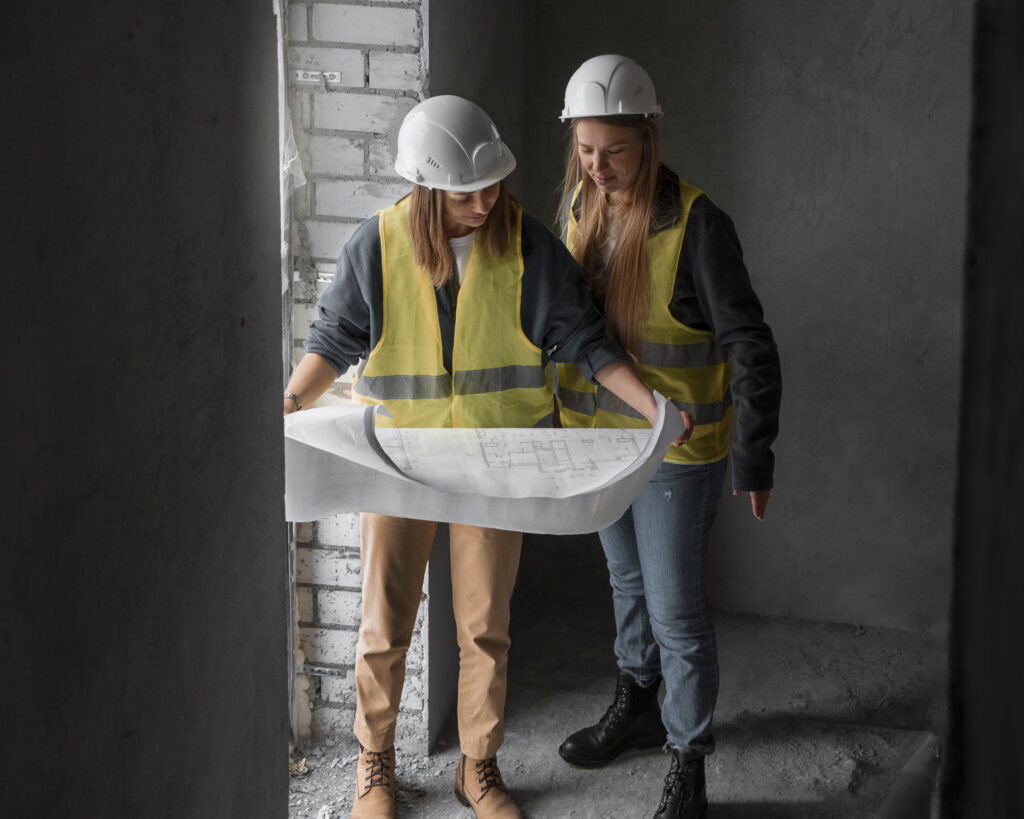Most people view construction as “men’s work.” With women holding only 11% of the construction jobs in the United States, it’s clearly a male-dominated field.1 But, it’s time to challenge this point of view and recognize the benefits of including more women in the industry. Empowering women in construction isn’t just about filling quotas— it’s about unlocking the industry’s true potential.
The Power of Gender Diversity in Construction
Empowering women in construction is an important decision that benefits entire companies. A study from McKinsey and Co. found that gender-diverse companies are 25% more likely to make more money than companies with fewer women.2 In other words, ensuring there are more women in the industry does more than help the women involved— it improves the success of the entire construction ecosystem.
1. Expanding the Talent Pool
The construction industry is facing a problem. The need for housing continues to grow, but there aren’t enough skilled workers to keep up. By 2031, about 41% of the construction workforce will retire.3 As baby boomers leave the industry, the labor gap will increase even more. Many companies feel the pressure to fix this problem.
Hiring more women could be the solution companies are looking for. Women make up half the population and provide a well of untapped talent. They bring their own set of skills and abilities that would create huge advantages. Companies should look to women to harness the full potential of the construction industry.
2. Increasing Construction Innovation
The construction industry often feels set in its ways. It’s not known for being quick to embrace change or innovation. But, introducing new ideas and processes can create real advantages for companies. They can make more money, work more efficiently, and experience greater longevity.
Studies show that diverse teams are more creative and better at problem-solving. In fact, gender-diverse teams increase innovation by 38%.4 This is because women bring their own unique life experiences, points of view, and knowledge to the construction industry. When men and women work together, they combine their strengths and expertise to create new ideas and better businesses.
3. The Crucial Role of Communication
Communication is extremely important in the construction industry. It creates safer job sites that focus on problem-solving and coordination between trades. Companies that communicate well are more likely to finish on time and under budget with a high-quality finished product.
Women are naturally good communicators. Rooted in the wiring of the female brain, women excel at empathy and active listening. As a result, they’re excellent at taking in multiple perspectives, analyzing data, and making decisions. This creates positive relationships and more efficient working environments.

Breaking Down Barriers: Addressing Challenges for Women in Construction
Bringing more women into the construction industry is a smart move with big advantages. But, supporting women in this field goes beyond just hiring them. The real aim is to help women stay in the industry and move up into leadership roles.
This happens when women have equal opportunities to learn and advance in their company. An inclusive environment allows women to become experts in their fields and true leaders. To find and keep talent, companies must acknowledge the challenges women face and create solutions to solve them.
1. Battling Stereotypes and Gender Bias
Stereotypes and gender bias are all too common in the construction industry. As the world changes and the role of women in society evolves, these unfair opinions become less common. But there’s still plenty of room to grow and improve.
Of the total population of women working in construction, only 2.5% of them work in the trades, with an overwhelming 87% working office jobs.1 This could be due to the stereotype that women have less physical strength and endurance than men.
Many people believe that women won’t be able to keep up with the physical nature of construction jobs. While working in the trades does require strength and endurance, you don’t need to be a bodybuilder. Above all, a strong work ethic makes a successful tradesperson. Strength is the rewarding byproduct of working hard over time. Depriving women of this opportunity does them a disservice.
2. Limited Representation
If you’re a woman working in construction, you’ve probably been in a situation where you’re the only woman on a job site. While some women naturally take on the role of pioneer, others find this position unwelcoming and isolating.
Women have their own challenges and struggles to overcome in the workplace. Without a supportive network for guidance and mentorship, some women can feel discouraged from staying in the industry long-term.
A sense of community and support can make all the difference. Networking groups provide mentorship and education to help women build connections and advance their careers in construction. The NAWIC (National Association of Women in Construction) is an excellent resource with branches all over the country. Or, if you’re located in the Raleigh, North Carolina area, check out Chicks of Construction, the networking group I created. This group helps women in construction network with each other and expand their careers, creating greater opportunities for success.

3. Safety Equipment and Gear for Women
In the past, women were stuck wearing men’s workwear and safety gear on the job site, which can be ill-fitting and uncomfortable. This raised safety concerns and contributed to a sense of exclusion amongst women in construction. In an industry where women often struggle to feel accepted, this added hurdle wasn’t helping.
Seeing this gap in the market, companies like Xena Workwear stepped up to solve the problem. Rather than just making the same bulky work boots in a smaller size, they focused on crafting boots that fit women comfortably while maintaining style and safety. Alongside brands like Dovetail Workwear and Covergalls, Xena Workwear provides high-quality workwear and PPE tailored specifically for women, empowering them to feel confident and stylish while bridging the gap between meetings and job sites. Companies like these help outfit the growing population of women in the industry and foster a sense of belonging.
How to Create a Supportive Work Environment for Women
To create a nurturing workplace, companies should extend their efforts beyond just hiring. While including more women in their team is a positive step, genuine empowerment goes beyond mere representation. It’s important for companies to create an atmosphere where women feel a sense of belonging and recognition.
1. Encourage diversity in leadership roles.
Companies with over 20% female representation in executive and managerial roles experience the biggest increase in innovation and efficiency.4 When women are in charge, they often create an environment where all team members feel safe to speak up and share their ideas. This culture of open expression and communication propels innovation, efficiency, and creativity. Equally important, it creates a work environment where lower-level employees feel heard and valued.
When women are in leadership positions, they also play a role in the hiring process. This helps fight against gender biases and stereotypes that creep in and lead to unfair treatment and discrimination. By eliminating biases and unjust practices, the industry becomes more inviting. This motivates women to see their value and take part in the industry’s growth.
2. Education and Training
Even in the most diverse companies, unwelcome behavior like hostility and bullying can occur. Sometimes, stereotypes and gender biases lurk beneath the surface, unnoticed by the majority. They can affect choices about who gets hired and promoted and how much they get paid. To fix these problems companies need the proper education and training to raise awareness and create solutions.
Education can take place within the company itself or with the help of external professionals. These experts take on the role of Diversity and Inclusion Specialists, Gender Diversity Consultants, or Efficiency Experts, to name a few.
A consultant comes equipped with a deep understanding of gender-related matters. They offer data-backed solutions and tailored strategies for each company’s unique needs. An outside consultant creates a safe space for women to share their experiences of discrimination without fearing backlash. While change can happen naturally, involving an outside influence can rapidly speed up positive change.
Gaining Fresh Perspectives with Mikki Paradis
Are you interested in creating change in your construction business?
Would you benefit from more innovation, efficiency, creativity, and communication?
Do you want to improve your company’s gender diversity, but don’t know where to start?
An external perspective could be just the thing your construction business needs.
With two decades of experience in the construction industry, I am intimately aware of the challenges women face at every employment tier. When I started PDI Drywall in 2005, people weren’t ready for a 23-year-old female entrepreneur. But I didn’t let that stop me. I dedicated myself to creating a business that prioritizes strong relationships, positive attitudes, and effective communication.
The outcome: PDI has blossomed into a prosperous, multi-million dollar drywall enterprise that works with some of North Carolina’s most accomplished development firms.
Apart from running my company, my passion lies in helping other women succeed in the construction industry. I work as a public speaker and consultant to help companies learn and improve. If your company needs education and training about gender diversity, effective communication strategies, project management, or efficiency benchmarks in the construction industry, don’t hesitate to get in touch today.
Citations:
- https://www.bls.gov/cps/cpsaat18.htm
- https://www.mckinsey.com/featured-insights/diversity-and-inclusion/diversity-wins-how-inclusion-matters
- https://www.nccer.org/newsroom/the-greater-impact-of-the-construction-labor-shortage-examined/
- https://www.bcg.com/publications/2017/people-organization-leadership-talent-innovation-through-diversity-mix-that-matters
- NAWIC: https://www.nawic.org/
- Chicks in Construction: https://chicksinconstruction.com/
Photos: www.freepik.com
- file:///Users/lilliankugel/Downloads/license-full-shot-woman-working-as-engineer-40133118.pdf
- file:///Users/lilliankugel/Downloads/license-full-shot–people-working-together-40133143.pdf
- https://xenaworkwear.com/products/valence-sd-safety-boot?variant=40285058138217


Write a Comment